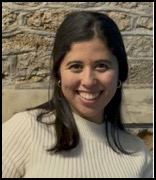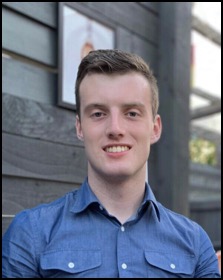Andrew Baldwin
Filed in: PI

Andrew studied Natural Sciences at the University of Cambridge, as a member of Trinity College. He completed his PhD in the laboratory of Chris Dobson in the department of Chemistry, studying the biophysical properties of amyloid fibrils. He then moved to Toronto to develop novel NMR techniques for studying protein dynamics under Prof Lewis Kay, with EMBO and CIHR postdoctoral fellowships. This work was subsequently recognised by a presentation of a Harrison-Meldola medal in 2013. Since September 2012, Andrew has been part of Oxford Chemistry as both a BBSRC David Phillip’s fellow and a Fitzjames fellow of Merton College. He is now Professor in Physical and Theoretical Chemistry, and a fellow of Pembroke College. He was awarded the 2016 BRSG-NMRDG NMR prize for ‘excellence in magnetic resonance’ as well as an ERC grant in 2021.
Andrew is a keen martial artist, qualifying as a 5th degree Taekwondo master in 2020.
CONTACT INFORMATION:
andrew.baldwin AT chem.ox.ac.uk
Biochemistry building
South Parks Road, Oxford OX1 3QU
Sonia Khemaissa
Filed in: Postdoc

Sonia is a postdoc working on liquid-liquid phase separation properties of some proteins. This particular property leads to the formation of membraneless organelles inside cells, with functions that are not yet fully understood. The aim of her research project is to decipher the function of these liquid droplets as catalysts for chemical reactions. Moreover, she is interested in studying how these proteins could or not interact with each other.
Sonia completed her PhD in 2023 under the supervision of Dr. Sandrine Sagan and Dr. Astrid Walrant at the Laboratoire des Biomolécules at Sorbonne Université in Paris, where she focused on understanding the mechanisms of membrane interaction and cellular uptake of cell penetrating peptides. She also obtained the French aggregation in physics and chemistry in 2019. She likes to spend her free time walking, reading, or meditating.
James Eaton
Filed in: DPhil

In addition to the project above, I am aiming to perform protein expression and purification of biologically important proteins, particularly those important to protein folding or aggregation. These will then be analysed by NMR to determine their structures and dynamics.
Outside of research, I like to go hiking or to the gym as it helps clear my mind. I can also be often found at one of the many pubs or bars that Oxford has to choose from.
Yaxin Deng
Filed in: DPhil

Ben Naylor
Filed in: DPhil

Morgan Wright
Filed in: DPhil

Suzanne Lim
Filed in: PartII

Suzanne is a Part II excited about all things NMR! Her project will include working on Seedless, the group's on-the-fly NMR pulse optimisation program, and eventually creating a pulse-optimised TOCSY/decoupling sequence. When not at her desk, she can be found at the climbing gym, or knitting/crocheting her next fibre arts project.
Imogen Airlie
Filed in: PartII

Outside of the lab, Imogen enjoys designing and sewing clothes for herself and her family / friends. Her favourite creation so far has been a black silk ball gown, which she proudly wore to the Merton Winter Ball.
Petra Pongsudhirak
Filed in: Part II

Emma Silvester
Filed in: Past Postdoc
Emma completed her PhD in Andrew Turberfield’s Lab in the department of physics, studying the folding properties of DNA and RNA nanostructures. Following her PhD, she worked as a postdoc in the Division of Structural Biology in Kay Grünewald's lab, using DNA nanostructures to develop new tools for cryo-electron microscopy and tomography. In the Baldwin lab, Emma was using cryo-electron tomography to study the structural properties of membraneless organelles, formed by phase separation of intrinsically disordered proteins.
Mark Hickling
Filed in: Past Postdoc
Mark's research is focussed on membraneless organelles and their ability to selectively enrich for certain RNA molecules. He is investigating how the properties of the RNA and the proteins that constitute these structures affect this poorly understood selection process, and uses a combination of deep sequencing and bioinformatics to do so. Outside of research he is usually found either on the squash court or getting frustrated watching Arsenal play football!
Charles Buchannan
Filed in: Past Postdoc
Charlie works on biological NMR method development. He is particularly interested in using NMR to unpick complex disease-relevant questions. Recently he has developed a technique to extensively characterise pathogen-ligand interactions using Saturation Transfer Difference NMR, underpinned by previous work on NMR spectral deconvolution. He is now focused on further applying spectral deconvolution to other experiments, aiming to expedite biological work with NMR. Outside of research, Charlie competed in the Oxford-Cambridge Boat Race in 2019. After completing his PhD he was postdoc in the Baldwin lab for a year and is now postdoc in Marburg.
Gogulan Karunanithy
Filed in: Past DPhil
Gogs completed his undergraduate degree in Chemistry at the University of Oxford, spending his Part II year in the Baldwin Group. He has completed an EPSRC-funded DPhil in the group, and is interested in NMR methodology development. Publications
CONTACT INFORMATION:
gogulan.karunanithy AT keble.ox.ac.uk
CONTACT INFORMATION:
gogulan.karunanithy AT keble.ox.ac.uk
Virginia Casablancas Antras
Filed in: Postdoc
Virginia was a doctoral student with the Systems Approaches to Biomedical Science CDT, and is jointly supervised by collaborators at EliLilly. The main aim of her research is understanding the mechanisms of amyloid protein aggregation and inhibition using NMR and chemical kinetics approaches. She has also recently started working on the partitioning of small molecules into membraneless organelles. She is generally interested in studying biologically relevant phenomena at the protein interaction level, and in the combination of modelling and experimental approaches.
Virginia’s background is in Biomedical Sciences (UAB, Spain, 2014) and she later completed an MRes in Molecular Biophysics at King’s College London, funded by a LaCaixa Fellowship for Postgraduate Studies in Europe. During her masters thesis in Prof. James McDonnell’s lab, she focused on the structural asymmetry and allostery of the immunoglobulin E constant region. After finishing her Dphil in group was working as a postdoc on the project about membraneless organelles, before starting a new role in the Nuffield Department of Medicine.
Outside the lab, Virginia plays the cello in the Oxford Millenium Orchestra, as well as being part of the Oxford University Table Tennis Team.
Virginia’s background is in Biomedical Sciences (UAB, Spain, 2014) and she later completed an MRes in Molecular Biophysics at King’s College London, funded by a LaCaixa Fellowship for Postgraduate Studies in Europe. During her masters thesis in Prof. James McDonnell’s lab, she focused on the structural asymmetry and allostery of the immunoglobulin E constant region. After finishing her Dphil in group was working as a postdoc on the project about membraneless organelles, before starting a new role in the Nuffield Department of Medicine.
Outside the lab, Virginia plays the cello in the Oxford Millenium Orchestra, as well as being part of the Oxford University Table Tennis Team.
Satoshi Kishigami
Filed in: Past DPhil
Mr. Satoshi Kishigami was a Dphil student at the University of Oxford. His research projects focused on the development of novel chemical probes to investigate structures and dynamics of high molecular weight macromolecules, and mechanistic study for potential treatments against neurodegenerative diseases. His study at Oxford has been founded by Keidanren (Japan Business Federation) Ishizaka Memorial Foundation, Ezoe Memorial Recruit Foundation, Shigeta Foundation and Sakaguchi International Scholarship Foundation.
Satoshi holds BSc in Applied Chemistry from Keio University, Tokyo and he also studied synthetic organic chemistry at Rice University, Texas where he conducted a research project about the synthesis of anti-cancer natural product derivatives under the supervision of Prof K. C. Nicolaou.
Satoshi holds BSc in Applied Chemistry from Keio University, Tokyo and he also studied synthetic organic chemistry at Rice University, Texas where he conducted a research project about the synthesis of anti-cancer natural product derivatives under the supervision of Prof K. C. Nicolaou.
David Miguel Dias
Filed in: Past Postdoc
David obtained his MSc. in Biochemistry at the University of Coimbra (Portugal). In 2011, he was awarded a PhD fellowship from the Portuguese Foundation for Science and Technology (FCT) to join the Ciulli and Abell laboratories in Cambridge (UK). Here he focused on targetting protein-protein interaction (PPIs) via fragment-based lead discovery approaches. David's work involves a wide set of bophysical methods but he has been mainly using NMR spectroscopy as a tool to screen and structurally validate fragment binding against several targets. David had joined the Baldwin group to explore the relationship between drug discovery and protein dynamics. He is interested in understanding how mechanisms of proteins aggregation in amyloid diseases can be better understood and potentially use that insight as a rationale for hit generation against amyloid-like proteins.
Publications
CONTACT INFORMATION:
david.dias AT chem.ox.ac.uk
Publications
CONTACT INFORMATION:
david.dias AT chem.ox.ac.uk
Reid Alderson
Filed in: Past DPhil
Reid studied Biochemistry (B.S.) at the University of Wisconsin-Madison, and is now a Ph.D. student in the National Institutes of Health (NIH) Oxford-Cambridge Scholars Program, in which he was also supervised by Ad Bax and Justin Benesch. Alongside other biophysical tools, Reid studied the structure, dynamics, and function of biomolecules with NMR spectroscopy and native mass spectrometry.
Publications
CONTACT INFORMATION:
reid.alderson AT pmb.ox.ac.uk
Magdeline Ira-Nathan
Filed in: PDRA
Tim Nott
Filed in: Past Postdoc
Tim obtained a PhD in structural biology at the National Institute for Medical Research (NIMR) in the UK, before moving to the Pawson Lab in Toronto, Canada, to pursue a postdoc in cell biology. Here, he studied how living cells are internally compartmentalised, and in particular how phase separation gives rise to liquid droplet-like membraneless organelles and compartments. In the Baldwin Lab, Tim is continuing his research on this theme, focussing on how the internal membraneless organelle environment influences biochemical reactions.
Tim was a Todd-Bird Junior Research Fellow at New College, Oxford.
Tim now runs a group in biochemistry in Oxford, funded by a Henry-Dale Wellcome/RSC fellowship.
Publications
CONTACT INFORMATION:
timothy.nott AT chem.ox.ac.uk
Tim was a Todd-Bird Junior Research Fellow at New College, Oxford.
Tim now runs a group in biochemistry in Oxford, funded by a Henry-Dale Wellcome/RSC fellowship.
Publications
CONTACT INFORMATION:
timothy.nott AT chem.ox.ac.uk
Henrik Müller
Filed in: Past Postdoc
Research interests
Fatal neurodegenerative diseases such as Alzheimer’s disease, Parkinson’s disease, and prion diseases (e.g. mad cow disease) share a common cause. Cellular proteins that, under normal circumstances have a functional role in the body, distort and form long amyloid fibrils, which are non-crystalline and heterogeneous, and can even be infectious. Henrik is interested in understanding (i) the structural details of how benign proteins are converted into causative agents of deadly diseases and (ii) the molecular mechanism by which the human defensive system, in the form of chaperoning small heat shock proteins, inhibits the formation of those protein fibrils.
Fatal neurodegenerative diseases such as Alzheimer’s disease, Parkinson’s disease, and prion diseases (e.g. mad cow disease) share a common cause. Cellular proteins that, under normal circumstances have a functional role in the body, distort and form long amyloid fibrils, which are non-crystalline and heterogeneous, and can even be infectious. Henrik is interested in understanding (i) the structural details of how benign proteins are converted into causative agents of deadly diseases and (ii) the molecular mechanism by which the human defensive system, in the form of chaperoning small heat shock proteins, inhibits the formation of those protein fibrils.
His work involves an inter-disciplinary combination of biophysical techniques such as electron microscopy (EM), atomic force microscopy (AFM), circular dichroism (CD) spectroscopy, differential ultracentrifugation, ion-mobility mass spectrometry (IMS), and chromatographic techniques with cell and animal-based toxicity assays and cutting edge high-molecular weight solution-state and solid-state NMR spectroscopy.
University and college roles and committees
Postdoctoral Research Associate, Department of Chemistry
Junior Research Fellow at Pembroke College
MPLS representative of the Oxford Research Staff Society (OxRSS)
Publications
CONTACT INFORMATION:
henrik.muller AT chem.ox.ac.uk
Mike Barber
Filed in: Past DPhil
Michael completed a biological sciences degree at the University of Leeds and is now enrolled on the interdisciplinary bioscience doctoral training partnership. Michael studies the structure and dynamics of RNA regulatory enzymes and Gaucher's disease associated Glucocerebrosidase.
Mike graduated in September 2016 and now worked in aid and development in Africa.
CONTACT INFORMATION:
michael.barber AT biodtp.ox.ac.uk
Mike graduated in September 2016 and now worked in aid and development in Africa.
CONTACT INFORMATION:
michael.barber AT biodtp.ox.ac.uk
Iva Pritišanac
Filed in: Past DPhil
Iva studied Molecular Biology (B.S.) at the University of Zagreb, Croatia, and subsequently moved to the University of Utrecht, the Netherlands, where she graduated in Molecular and Cellular Life Sciences (M.S.). During her master studies Iva focused on structural biology, performing her major and minor research projects in NMR spectroscopy and X-ray crystallography, respectively. Iva's master's thesis focused on the usefulness of distance restraints derived from EPR and sm-FRET spectroscopic techniques as applied to the computational docking of protein-protein and protein-nucleic acid complexes with HADDOCK. Her interest in using restraints from experimental techniques in computational structural biology continues in her PhD research, which focuses on using experimental restraints from solution-state NMR spectroscopy to automate resonance assignment in spectra of high molecular weight proteins.
Iva graduated in December 2016 and now worked in Frankfurt with Prof. Peter Guntert.
Publications
CONTACT INFORMATION:
iva.pritisanac AT magd.ox.ac.uk
Iva graduated in December 2016 and now worked in Frankfurt with Prof. Peter Guntert.
Publications
CONTACT INFORMATION:
iva.pritisanac AT magd.ox.ac.uk
Olga Tkachenko
Filed in: Past DPhil
Olga studied Natural Sciences (Biochemistry) at the University of Cambridge as a member of St. Catharine's College, and spent a year as an exchange student at the University of Heidelberg. She is now a DPhil student and a Lamb and Flag Scholar at St John's College. Olga is interested in conformational dynamics of proteins and in combining advanced biophysical methods to study them, and is supervised jointly by Andrew and by Justin Benesch.
Publications
CONTACT INFORMATION:
olga.tkachenko AT sjc.ox.ac.uk
Publications
CONTACT INFORMATION:
olga.tkachenko AT sjc.ox.ac.uk